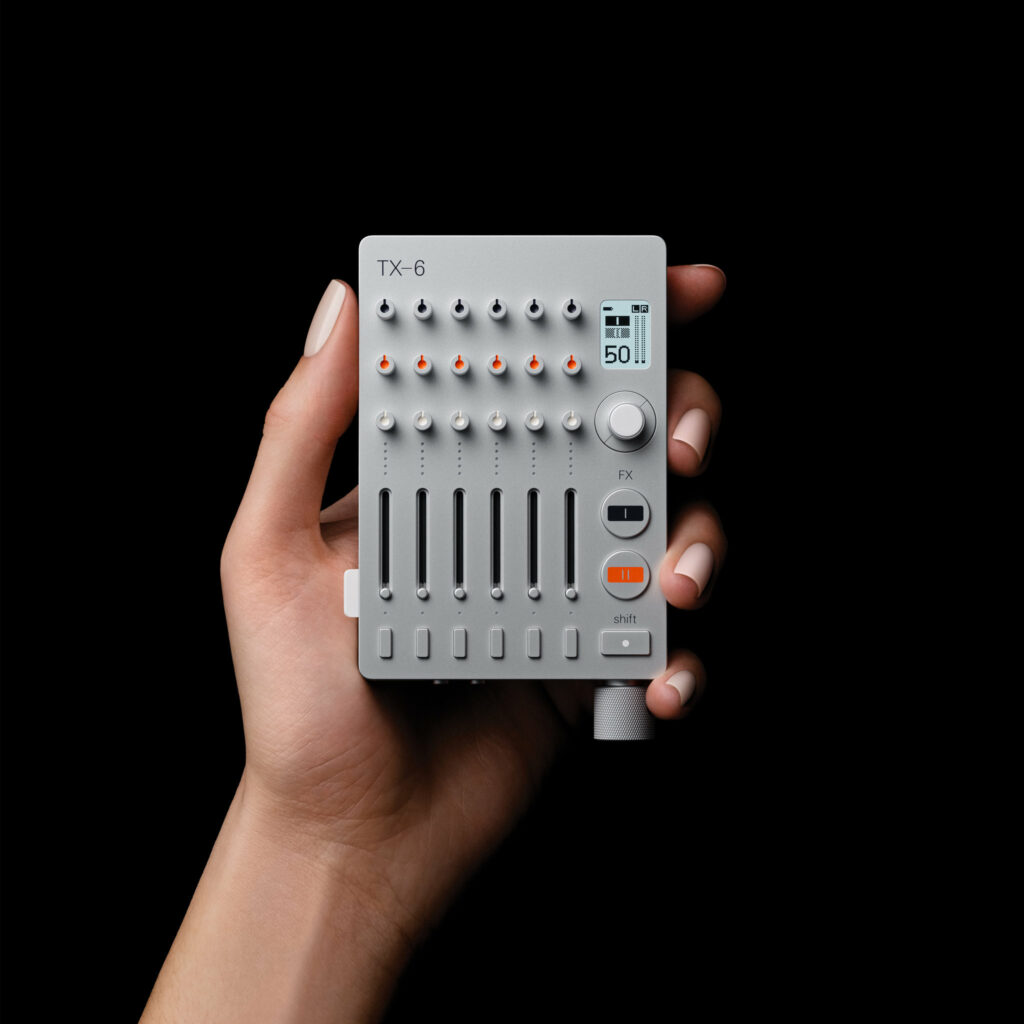A six-channel mixer and audio interface with dozens of tricks up its sleeve, the TX-6 is tiny, but who’s it aimed at? Greg Scarth finds out.

Teenage Engineering’s unique approach isn’t for everyone. Some 11 years and one major update since the release of the Stockholm-based company’s debut OP-1 synth, there are still some who question its looks, price and whether it’s ‘just a toy’. At the other end of the spectrum, the brand’s Pocket Operator range has been pivotal in bringing affordable and innovative instruments to the mass market, alongside similarly portable offerings like the Korg Volca series. This is a company not afraid to push the envelope. The Teenage Engineering TX-6 is the latest addition to the product range, and it’s a typically quirky offering.
First impressions are that the TX-6 is beautifully made and absolutely tiny. No kidding, this goes beyond what you might consider compact and portable into entirely new realms of minituarisation; at just 90mm tall, 62mm wide and weighing in at 160 grams, the TX-6 is almost absurdly small and light for any pro audio device. In fact, the TX-6 is so compact that there’s even been a lot of online debate about whether the spacing of the input sockets renders it unusable. Is it really possible that a design team as fastidious as Teenage Engineering would make a blunder which stopped you being able to use regular cables? In a word, no. The spacing of the sockets necessitates the use of low-profile connectors such as the company’s own slimline cables, but let’s make it clear from the beginning that compactness is about 50% of the TX-6’s USP; if you don’t need or want it to be portable, there are plenty of other (cheaper) alternatives out there for you.

In terms of feature set, the TX-6 is a bit of a hybrid in much the same way that the OP-1 is an unusual mash-up of synth, sampler, recorder and sequencer in a compact format. Teenage Engineering describe it as a six-channel mixer first and foremost, which is underselling it to a ludicrous extent. It’s also an ultra-high-quality battery-powered audio interface and a field recorder, with built-in synthesiser, drum machine and sequencer features, MIDI and Bluetooth support. There are built-in effects, customisable controls, a DJ mixer mode and full iOS support. It’s also worth noting that those six channels are all stereo, but can also be used in mono or ‘split’ modes for up to 12 channels in total. In short, the TX-6 is a multi-function all-rounder which doesn’t quite fit into any existing product category; it’s designed for versatility and, based on what we’ve seen with the OP-1, likely to be upgraded and improved for years to come via firmware updates.

The user interface of the TX-6 is nicely considered, based around a clear 48×64 pixel monochrome display and a main rotary select knob/button, similar to what you’d find on the OP-1. The select knob combines with the shift key and various dedicated controls – aux and cue pages, effect buttons and so on – give you access to the menu system which allows you to choose from the varied setups and features of the unit. The documentation breaks this down into a total of 91 ‘system screens’ for different features, but the updated total is already over 100 with the release of the version 1.1.4 firmware at the end of June. While there’s a bit of work to figure out some of the button combinations, you’ll quickly get used to accessing the most important features.
Physical controls on the unit are understandably small, but once again that’s a design choice rather than a flaw. The high-quality sliders, knobs and buttons take a bit of getting used to, but they feel quality. The ability to customise the controls on the front panel feels like a particularly well thought-out approach. Rather than having dedicated EQ and pan controls for the six channels, you instead have three ‘parametrer knobs’ – blue, orange and white – which default to three-band EQ but can be assigned to whichever key parameters you need to access, options including filter cutoff, compressor threshold, aux send level, oscillator frequency or sequencer note length.

Other than the compactness, what stands out about the TX-6 is the sheer sound quality. There’s no doubt that this is genuinely a professional piece of equipment which just happens to look like a toy, very much like the OP-1 is a serious synth and sequencer with a deceptively lighthearted design. The big question is who the TX-6 is designed for. At just over £1,000 it’s certainly not a budget option. There are much cheaper mixers, much cheaper interfaces and much cheaper synths, but with that said, there’s absolutely nothing which matches the TX-6 for combining all those features in anything close to its size. If you don’t need it to be portable, a combination of an interface, synth and mixer will do the same job, but if you can afford the asking price of the TX-6 then it’s worth every penny to get the ultimate in portability. It’s not for everyone, but people who get it will absolutely love it.
Greg Scarth
More info/buy